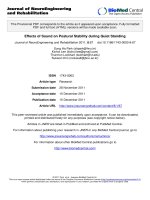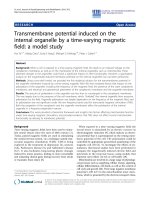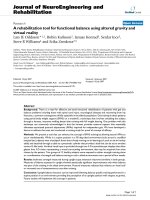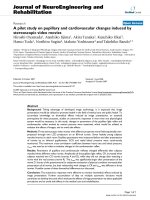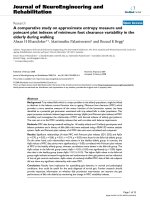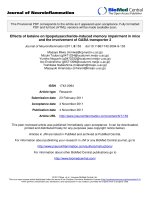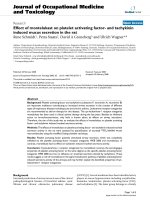Báo cáo hóa học: " Electrical Conductivity Studies on Individual Conjugated Polymer Nanowires: Two-Probe and Four-Probe Resu" potx
Bạn đang xem bản rút gọn của tài liệu. Xem và tải ngay bản đầy đủ của tài liệu tại đây (537.32 KB, 6 trang )
NANO EXPRESS
Electrical Conductivity Studies on Individual Conjugated Polymer
Nanowires: Two-Probe and Four-Probe Results
Yun Ze Long
•
Jean Luc Duvail
•
Meng Meng Li
•
Changzhi Gu
•
Zongwen Liu
•
Simon P. Ringer
Received: 20 August 2009 / Accepted: 14 October 2009 / Published online: 13 November 2009
Ó to the authors 2009
Abstract Two- and four-probe electrical measurements
on individual conjugated polymer nanowires with different
diameters ranging from 20 to 190 nm have been performed
to study their conductivity and nanocontact resistance. The
two-probe results reveal that all the measured polymer
nanowires with different diameters are semiconducting.
However, the four-probe results show that the measured
polymer nanowires with diameters of 190, 95–100, 35–40
and 20–25 nm are lying in the insulating, critical, metallic
and insulting regimes of metal–insulator transition,
respectively. The 35–40 nm nanowire displays a metal–
insulator transition at around 35 K. In addition, it was
found that the nanocontact resistance is in the magnitude of
10
4
X at room temperature, which is comparable to the
intrinsic resistance of the nanowires. These results dem-
onstrate that four-probe electrical measurement is neces-
sary to explore the intrinsic electronic transport properties
of isolated nanowires, especially in the case of metallic
nanowires, because the metallic nature of the measured
nanowires may be coved by the nanocontact resistance that
cannot be excluded by a two-probe technique.
Keywords Nanowires Á Conductivity Á
Nanocontact resistance Á Conducting polymers Á
Template synthesis
Introduction
Recently, one-dimensional nanostructures, such as carbon
nanotubes [1], inorganic semiconductor nanowires [2] and
conjugated polymer nanowires [3], have become the sub-
ject of intense investigations due to their importance for
both fundamental research and potential applications in
nanoscale devices. Among numerous kinds of nanostruc-
tures, conducting polymer nanowires and nanotubes, such
as polyaniline, polypyrrole and poly(3,4-ethylenedioxy-
thiophene) (PEDOT), are promising materials for fabri-
cating polymeric nanodevices. By now, electronic transport
properties (e.g., electrical conductivity) of nanodevices
based on individual conducting polymer nanotubes and
nanowires have been explored by various techniques such
as the two-probe technique based on a conductive scanning
probe microscope [4–6]. The common approach to the
two-probe technique is generally realized by dispersing
nanotubes/wires on photo- or electron-beam lithographic-
prepatterned microleads or nanoleads and the subsequent
searching of nanofibers lying on two or four leads only
[7–12]. In addition, electron- and/or focused ion beam
assisted deposition technique has been employed to attach
metal microleads on isolated nanotubes/wires [13–18].
A facile technique for fabrication and measurement of
polymer nanowire arrays between electrodes in channels
was also reported [19].
Y. Z. Long (&) Á M. M. Li
College of Physics Science, Qingdao University,
266071 Qingdao, China
e-mail:
J. L. Duvail
Institut des Mate
´
riaux Jean Rouxel, CNRS,
Universite
´
de Nantes, 44322 Nantes, France
C. Gu
Beijing National Laboratory for Condensed Matter Physics,
Institute of Physics, Chinese Academy of Sciences, 100190
Beijing, China
Z. Liu Á S. P. Ringer
Australian Key Centre for Microscopy and Microanalysis,
The University of Sydney, Sydney, NSW 2006, Australia
123
Nanoscale Res Lett (2010) 5:237–242
DOI 10.1007/s11671-009-9471-y
Although lots of effort on the electronic transport
measurement of individual polymer fibers has been done,
some key questions are still unclear, such as whether the
two-probe measurements can reveal the intrinsic electronic
transport properties of single polymer nanowires and how
the nanocontacts can affect the results. These questions are
very important for the fabrication and characterization of
nanodevices based on individual nanofibers through elec-
tron-beam lithography and/or focused ion beam deposition.
Since an insulating or semiconducting layer could be
formed at the interface between a metal lead and a nano-
wire/tube, the contact resistance of such electronic contact
may be strongly temperature dependent and this can seri-
ously complicate or even dominate the measured resistance
of the nanowire/tube. Up to now, there have been efforts
addressing this problem in the measurements of carbon
nanotubes [20, 21] and individual metal oxide nanowires
such as IrO
2
[22], SnO
2
[23], ZnO [24] and RuO
2
[25]
nanowires. For instance, two- and four-probe electrical
measurements on individual SnO
2
nanowires have been
performed to evaluate their conductivity and contact
resistance [23]. Lin et al. [24] have studied the electronic
transport properties of a single ZnO nanowire and RuO
2
nanowire [25] through their contacts with a metal elec-
trode. However, the nanocontact between a metal lead and
a polymer nanowire has not been precisely explored yet.
In our previous works [15–18], we measured the elec-
trical conductivity of isolated conjugated polymer nanofi-
bers and the contact resistance of two crossed polyaniline
nanotubes. In this paper, we focus on two- and four-probe
electrical measurements on individual PEDOT nanowires
with different diameters ranging from 20 to 190 nm. It was
found that if the temperature dependence of the nanowire
resistance is weak, the resistance of the nanocontact between
a metal lead and a polymer nanowire can dominate the low-
temperature resistance, and thus overshadow the metallic
behavior of the measured nanowire. One such case is
when the nanowire is lying in the metallic regime of metal–
insulator transition. So a four-probe electrical measurement
is necessary to reveal the intrinsic electronic transport
properties of individual (metallic) polymer nanofibers.
Experimental
The PEDOT nanowires were prepared in templates of
polycarbonate track-etched membranes [18, 26–28]. In a
typical synthesis procedure, we used a gold layer evapo-
rated on one side of the membrane as the working elec-
trode, a platinum plate as the counter electrode and a
saturated calomel electrode as the reference. The poly-
merization bath consisted of an aqueous solution contain-
ing 0.07 M sodium dodecyl sulfate, 0.1 M LiClO
4
and
0.05 M 3,4-ethylenedioxythiophene (provided by BAYER
AG and distilled before using). The electrochemical poly-
merization was carried out at a fixed potential of 0.8 V vs.
saturated calomel electrode with an EGG 273 potentiostat.
After the polymerization, polycarbonate (the membrane
template) was removed by dissolution with a flow of
dichloromethane, and the nanowires were dispersed onto a
SiO
2
wafer. The resulting PEDOT nanowires were char-
acterized by a field-emission scanning electron microscope
(SEM), a transmission electron microscope, Raman spec-
tra, X-ray photoelectron spectra and electron spin reso-
nance. More details can be found in Ref. [26–28].
The way of attaching Pt microleads on an isolated
nanowire was described in previous publications [15–18].
First, we used a scanning electron microscope to find an
appropriately isolated PEDOT nanowire on the wafer.
Then, two pairs of Pt microleads typically 0.5 lm in width
and 0.4 lm in thickness were fabricated by FIB deposition
(Dual-Beam 235 FIB System from FEI Company, working
voltage of the system is 5 kV for the electron beam and
30 kV for the focused ion beam, respectively, current of the
focused ion beam is 1–10 pA), as shown in Fig. 1. Finally,
electrical connection between the Pt microleads and the
sample holder was made by highly conductive silver paste
and gold wires. Electrical measurements of individual PE-
DOT nanowires were carried out using a Keithley 236
source measure unit in a helium gas flow cryostat (Oxford),
or a Physical Property Measurement System from Quantum
Design and a Keithley 6487 picoammeter/voltage source
covering a wide temperature range of 10–300 K. The four-
probe resistance was measured by applying a very small
current (I = 0.01–10 nA, corresponding voltage V =
0.0005–0.02 V) in a range where the I–V characteristics
were linear. The two-probe resistance was determined
under V
bias
= 0.02 V. The same PEDOT nanowire was
used for four-probe measurement first and then for two-
probe measurement. The resistance of the polymer nano-
wire with a given diameter was measured at least twice, for
example, under cooling and during heating. The reproduc-
ibility of the results has been good. In addition, for nano-
wires with a given diameter, two or more individual
nanowires were measured to check the reproducibility.
Results and Discussion
As we know, in the four-probe method, the measured
resistance R
4P
is the intrinsic nanowire resistance of the
measured segment. However, in the two-probe method, the
measured resistance R
2P
is given by R
2P
= R
lead1
?
R
con1
? R
4P
? R
con2
? R
lead2
= R
lead
? R
con
? R
4P
,where
R
lead
= R
lead1
? R
lead2
is the resistance of the two micro-
leads and R
con
= R
con1
? R
con2
is the contact resistance of
238 Nanoscale Res Lett (2010) 5:237–242
123
the two microlead–nanowire contacts. The two major fac-
tors that affect the contact resistance are the geometry and
the insulating layers (potential barriers) between the con-
tacting surfaces. The resistance of a contact is inversely
proportional to its area, and it is dependent on the force
holding the two surfaces together, their stiffness and the
respective electronic structure of the two materials. In the
present case, the platinum microlead fabricated by FIB
deposition can promise a good contact with the nanowire.
However, insulating layers (potential barriers) between the
nanowire and the platinum microleads are inevitable
because they have different energy levels or work func-
tions. In addition, contamination of the nanowire surfaces
from solvent or water adsorption may also increase the
potential barrier width and height.
In this study, the resistance R
lead
of the two Pt micro-
leads is less than 1 kX (estimated using the widely rec-
ognized resistivity of 5 9 10
-4
X cm for the deposited Pt
film under the conditions used for the FIB deposition [29]),
whereas the nanowire resistance R
4P
and the contact
resistance R
con
are usually larger than 20 kX (as described
below). So, R
lead
is negligibly small compared with R
4P
and R
con
, and hence can be ignored, thus we get R
2P
=
R
con
? R
4P
. It is obvious that if R
con
) R
4P
, then
R
2P
& R
con
, and if R
con
( R
4P
, then it is R
2P
& R
4P
.
Through electrical measurements on many isolated
PEDOT nanowires with different diameters, the room
temperature conductivities of the nanowires with diameters
of 190, 95–100, 35–40 and 20–25 nm were obtained that
are about 11.2, 30–50, 490–530 and 390–450 S/cm,
respectively. The room temperature conductivity increases
with the decrease of outer diameter of the conducting
polymer nanofibers. This was also reported by Martin et al.
[30] previously, and could be ascribed to the enhancement
of molecular and super-molecular ordering (alignment of
the polymer chains).
Figure 2 shows the four-probe and two-probe test results
of resistances for isolated PEDOT nanowires with different
diameters ranging from 20 to 190 nm. For the 190 nm
PEDOT nanowire that is lying in the insulating regime of
the metal–insulator transition, as shown in Fig. 2a, the two-
probe resistance R
2P
is quite close to the four-probe resis-
tance R
4P
from 20 to 300 K, and both R
2P
and R
4P
have
strong temperature dependence. These results indicate that
compared with the intrinsic nanowire resistance of the
measured segment, the microlead–nanowire contact resis-
tance is small and negligible. For four-probe resistance of
the 95–100 nm PEDOT nanowire, as shown in Fig. 2b, it
has a relatively weak temperature dependence and is close
to the critical regime of metal–insulator transition. It is
interesting to find that the two-probe resistance R
2P
is quite
close to the four-probe resistance R
4P
at higher tempera-
ture; however, at low temperature, R
2P
increases sharply
especially below 25 K and becomes much larger than R
4P
.
For the 35–40 nm PEDOT nanowire, as shown in Fig. 2c,
the result of the four-probe resistance R
4P
(T) indicates that
the nanowire is lying in the metallic regime of metal–
insulator transition and there is a transition at around 35 K.
It should be mentioned here that R
4P-1
(T) was measured
first, and R
4P-2
(T) was measured 6 months later. However,
the two-probe resistance R
2P
only increases monotonously
with temperature lowering, indicating that R
2P
is domi-
nated by the contact resistance that is R
2P
& R
con
, espe-
cially below 100 K. For the 20–25 nm PEDOT nanowire,
which is also lying in an insulating regime, as shown in
Fig. 2d, both R
2P
and R
4P
have strong temperature depen-
dence. It seems that both R
con
and R
4P
are very large and
cannot be ignored for the measured 20–25 nm nanowire.
Here, it should be noted that although the 20–25 nm
PEDOT nanowire has a relatively high conductivity at room
temperature (390–450 cm/S), the nanowire shows very
strong temperature dependence (R(10 K)/R(300 K) * 10
5
)
Fig. 1 SEM images of template-synthesized PEDOT nanowires and the attached four Pt microleads
Nanoscale Res Lett (2010) 5:237–242 239
123
or insulating behavior possibly due to confining effect
limited by the small diameter of the nanowire. It is well
known that such an effect should occur when a character-
istic physical length is comparable to the diameter. In the
present case, the diameter (20–25 nm) of the PEDOT
nanowire is equal or close to the localization length of
electrons Lc(Lc * 20 nm for conducting polymers close to
the metal–insulator transition [31]); therefore, localization
of electrons induced by Coulomb interaction or small dis-
order must be taken into account in order to explain the
insulating behavior especially at low temperature.
By employing the two-probe and four-probe methods,
the electronic contact resistances, R
con
(T), have been
determined. We found that the room temperature R
con
and
R
4P
for the PEDOT nanowires are at the same order of
magnitude. For example, R
con
is 63 and 46 kX, and R
4P
is
53 and 24 kX for the measured 35–40 and 20–25 nm PE-
DOT nanowires, respectively. However, R
con
(T) increases
rapidly with decreasing temperature, as shown in Fig. 3,
indicating an insulating or semiconducting contact formed
at the interfaces between the Pt microlead and the polymer
nanowire. Lin et al. [25] reported the electronic contact
resistances formed between electron-beam lithographic-
patterned submicron Cr/Au electrodes and single metallic
RuO
2
, IrO
2
and Sn-doped In
2
O
3-x
nanowires. They found
that the contact resistances can range from several tens/
hundreds of Ohm to several tens of kOhm at 300 K, and
their temperature dependences can be well described by a
thermal fluctuation-induced tunneling (FIT) conduction
model proposed by Sheng [32], which describes the tem-
perature-dependent resistance across a single small junc-
tion as R(T) = R
0
exp[T
1
/(T
0
? T)], where R
0
is a
parameter that weakly depends on temperature only, and T
1
and T
0
are characteristic temperatures. In the present case,
the fitting values for the three parameters R
0
, T
1
and T
0
are
52 kX, 63.6 K and 5.16 K for the 35–40 nm nanowire, and
0
100k
1M
10M
100M
1G
(a)
1001 300
PEDOT nanowire
190 nm
4P
2P
R (Ω)
T (K)
100k
1M
10M
10010 300
2P
4P
(b)
PEDOT nanowire
95-100 nm
R(Ω)
T(K)
100k
1M
(c)
4P-1
4P-2
2P
100 200 300
10
PEDOT nanowire
35-40 nm
R (Ω)
T (K)
1M
10k
100k
10M
100M
4P
2P
10030
300
(d)
20-25 nm
PEDOT nanowire
R (Ω)
T (K)
Fig. 2 Temperature dependence of four-probe (4P) and two-probe (2P) resistances for individual template-synthesized PEDOT nanowires with
diameters a 190 nm, b 95–100 nm, c 35–40 nm and d 20–25 nm
100k
1M
10M
b
a
100
300
30
a: 35-40 nm PEDOT nanowire
b: 20-25 nm PEDOT nanowire
R (Ω)
con
T (K)
Fig. 3 Temperature dependence of nanocontact resistance (R
con
=
R
2P
– R
4P
) determined from Fig. 2c, d
240 Nanoscale Res Lett (2010) 5:237–242
123
37 kX, 255.2 K and 4.04 K for the 20–25 nm PEDOT
nanowire, respectively. Here, for comparison, the contact
resistances of the 190 and 95–100 nm nanowires have been
the calculated contact resistances that are equal to 11 and
18 KX at room temperature, respectively, and are smaller
than that in the case of 35–40 and 20–25 nm nanowires (63
and 46 kX). It seems that owing to the decrease of the
contact area between the nanowire and the platinum mi-
croleads, the nanocontact resistance at low temperature
increases with diameter decreasing and shows much
stronger temperature dependence.
The earlier results demonstrate that the nanocontact
resistance is an important issue in electrical resistance
measurements on isolated nanowires, which may dominate
the measured two-probe resistance especially at low tem-
peratures. Compared with the two-probe method, we
believe that the four-probe measurement can further reveal
the intrinsic electronic transport properties of the nanowires.
For example, the two-probe results in Fig. 2 just indicate
that all the measured PEDOT nanowires are semiconduct-
ing. However, the four-probe results reveal the metallic
behavior of the 35–40 nm PEDOT nanowire below 35 K. In
addition, for individual RuO
2
nanowires [25], it was also
reported that the temperature dependence of two-probe
resistance indicates that the nanowire is semiconducting,
whereas the four-probe resistance dependence of the same
nanowire shows the measured nanowire is metallic.
Though the metallic behavior and metal–insulator tran-
sition have been observed in bulk films of doped polyacet-
ylene, polypyrrole, PEDOT, poly(p-phenylenevinylene)
(PPV) and polyaniline [31, 33–35], similar metallic behav-
ior and metal–insulator transition have rarely been reported
for isolated polymer nanowires/tubes. It is generally
believed that nanosize effect, disorder-induced localization
of the charge carriers and enhanced electron–electron
interaction-induced localization could be possible reasons to
degrade the metallic behavior of nanowires/tubes [3, 9, 15,
18, 36]. Based on our results, we propose that nanocontact
resistance may be one of the key reasons for this degrada-
tion. In most published results, the temperature-dependent
resistance of a single nanowire/tube was determined by
two-probe technique; therefore, the metallic nature of the
measured polymer fibers could be overshadowed by the
nanocontact resistance especially at low temperatures (such
as the 35–40 nm PEDOT nanowire as shown in Fig. 2c)
although the nanofibers show a relatively high electrical
conductivity at room temperature.
Conclusions
In summary, we have performed two- and four-probe
electrical measurements on individual conducting polymer
PEDOT nanowires with different diameters ranging from
20 to 190 nm. The four-probe results reveal that the mea-
sured PEDOT nanowires with diameters of 190, 95–100,
35–40 and 20–25 nm are lying in the insulating, critical,
metallic and insulting regimes of metal–insulator transi-
tion, respectively. The two-probe results, however, reveal
that all the measured PEDOT nanowires are semicon-
ducting due to the microlead–nanowire contact resistances
that show semiconducting or insulating behavior at low
temperatures. These results indicate that four-probe elec-
trical measurement is necessary to explore the intrinsic
electronic transport properties of individual nanowires,
especially in the case of metallic nanowires due to the
effect of the nanocontact resistance that cannot be excluded
in the two-probe measurement.
Acknowledgments This work was financially supported by the
National Natural Science Foundation of China (Grant No 10604038)
and the Program for New Century Excellent Talents in University of
China (Grant No NCET-07-0472) and by the Communaute
´
urbaine
de Nantes, France.
References
1. P. Sharma, P. Ahuja, Mater. Res. Bull. 43, 2517 (2008)
2. Y. Xia, P. Yang, Y. Sun, Y. Wu, B. Mayers, B. Gates, Y. Yin, F.
Kim, H. Yan, Adv. Mater. 15, 353 (2003)
3. A.N. Aleshin, Adv. Mater. 18, 17 (2006)
4. J.G. Park, S.H. Lee, B. Kim, Y.W. Park, Appl. Phys. Lett. 81,
4625 (2002)
5. S.K. Saha, Y.K. Su, C.L. Lin, D.W. Jaw, Nanotechnology 15,66
(2004)
6. L. Liu, Y. Zhao, N. Jia, Q. Zhou, C. Zhao, M. Yan, Z. Jiang, Thin
Solid Films 503, 241 (2006)
7. A.G. MacDiarmid, W.E. Jones, I.D. Norris, J. Gao, A.T. Johnson,
N.J. Pinto, J. Hone, B. Han, F.K. Ko, H. Okuzaki, M. Llaguno,
Synth. Metals 119, 27 (2001)
8. J.G. Park, G.T. Kim, V. Krstic, B. Kim, S.H. Lee, S. Roth, M.
Burghard, Y.W. Park, Synth. Metals 119, 53 (2001)
9. S. Samitsu, T. Shimonura, K. Ito, M. Fujimori, S. Heike, T.
Hashizume, Appl. Phys. Lett. 86, 233103 (2005)
10. B.K. Kim, Y.H. Kim, K. Won, H. Chang, Y. Choi, K.J. Kong,
B.W. Rhyu, J.J. Kim, J.O. Lee, Nanotechnology 16, 1177 (2005)
11. B.H. Kim, D.H. Park, J. Joo, S.G. Yu, S.H. Lee, Synth. Metals
150, 279 (2005)
12. L. Gence, S. Faniel, C. Gustin, S. Melinte, V. Bayot, V. Callegari,
O. Reynes, S. Demoustier-Champagne, Phys. Rev. B 76, 115415
(2007)
13. X. Zhang, J.S. Lee, G.S. Lee, D.K. Cha, M.J. Kim, D.J. Yang,
S.K. Manohar, Macromolecules 39, 470 (2006)
14. Z.H. Yin, Y.Z. Long, C.Z. Gu, M.X. Wan, J.L. Duvail, Nanoscale
Res. Lett. 4, 63 (2009)
15. Y.Z. Long, L.J. Zhang, Z.J. Chen, K. Huang, Y.S. Yang, H.M.
Xiao, M.X. Wan, A.Z. Jin, C.Z. Gu, Phys. Rev. B 71, 165412
(2005)
16. Y.Z. Long, Z.J. Chen, J.Y. Shen, Z. Zhang, L.J. Zhang, K. Huang,
M.X. Wan, A. Jin, C.Z. Gu, J.L. Duvail, Nanotechnology 17,
5903 (2006)
17. Y.Z. Long, L.J. Zhang, Y.J. Ma, Z.J. Chen, N.L. Wang, Z. Zhang,
M.X. Wan, Macromol. Rapid Commun. 24, 938 (2003)
Nanoscale Res Lett (2010) 5:237–242 241
123
18. Y.Z. Long, J.L. Duvail, Z.J. Chen, A.Z. Jin, C.Z. Gu, Chin. Phys.
Lett. 25, 3474 (2008)
19. K. Ramanathan, M.A. Bangar, M. Yun, W. Chen, A. Mulchan-
dani, N.V. Myung, Nano Lett. 4, 1237 (2004)
20. C. Lan, P. Srisungsitthisunti, P.B. Amama, T.S. Fisher, X. Xu,
R.G. Reifenberger, Nanotechnology 19, 125703 (2008)
21. Q. Chen, S. Wang, L.M. Peng, Nanotechnology 17, 1087
(2006)
22. Y.H. Lin, Y.C. Sun, W.B. Jian, H.M. Chang, Y.S. Huang, J.J. Lin,
Nanotechnology 19, 045711 (2008)
23. F. Herna
´
ndez-Ramı
´
rez, A. Taranco
´
n, O. Casals, J. Rodrı
´
guez,
A. Romano-Rodrı
´
guez, J.R. Morante, S. Barth, S. Mathur, T.Y.
Choi, D. Poulikakos, V. Callegari, P.M. Nellen, Nanotechnology
17, 5577 (2006)
24. Y.F. Lin, W.B. Jian, C.P. Wang, Y.W. Suen, Z.Y. Wu, F.R. Chen,
J.J. Kai, J.J. Lin, Appl. Phys. Lett. 90, 223117 (2007)
25. Y.H. Lin, S.P. Chiu, J.J. Lin, Nanotechnology 19, 365201 (2008)
26. J.L. Duvail, P. Re
´
tho, V. Fernandez, G. Louarn, P. Molinie
´
,O.
Chauvet, J. Phys. Chem. B 108, 18552 (2004)
27. J.L. Duvail, Y.Z. Long, S. Cuenot, Z. Chen, C. Gu, Appl. Phys.
Lett. 90, 102114 (2007)
28. J.L. Duvail, Y. Long, P. Retho, G. Louarn, L. Dauginet De Pra,
S. Demoustier-Champagne, Mol. Cryst. Liq. Cryst. 485, 835 (2008)
29. G.D. Marzi, D. Iacopino, A.J. Quinn, G. Redmond, J. Appl. Phys.
96, 3458 (2004)
30. C.R. Martin, Acc. Chem. Res. 28, 61 (1995)
31. R. Menon, C.O. Yoon, D. Moses, A.J. Heeger, in Handbook of
conducting polymers, 2nd edn., ed. by T.A. Skotheim, R.L.
Elsenbaumer, J.R. Reynolds (Marcel Dekker, New York, 1998),
p. 85
32. P. Sheng, Phys. Rev. B 21, 2180 (1980)
33. A.J. Heeger, Synth. Metals 125, 23 (2002)
34. Y.Z. Long, Z.J. Chen, N.L. Wang, J.C. Li, M.X. Wan, Physica B
344, 82 (2004)
35. K. Lee, S. Cho, S.H. Park, A.J. Heeger, C.W. Lee, S.H. Lee,
Nature 441, 65 (2006)
36. Y.B. Khavin, M.E. Gershenson, A.L. Bogdanov, Phys. Rev. B 58,
8009 (1998)
242 Nanoscale Res Lett (2010) 5:237–242
123


